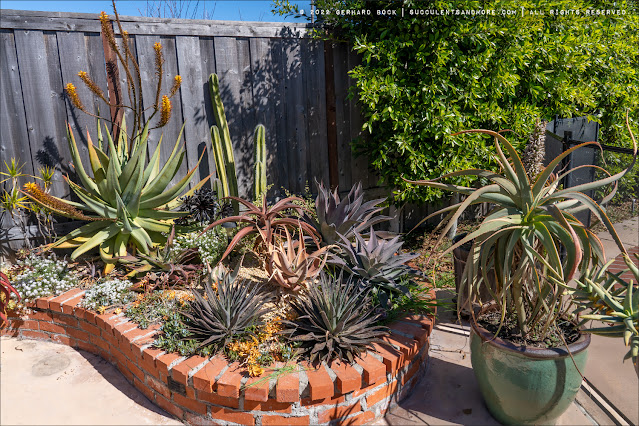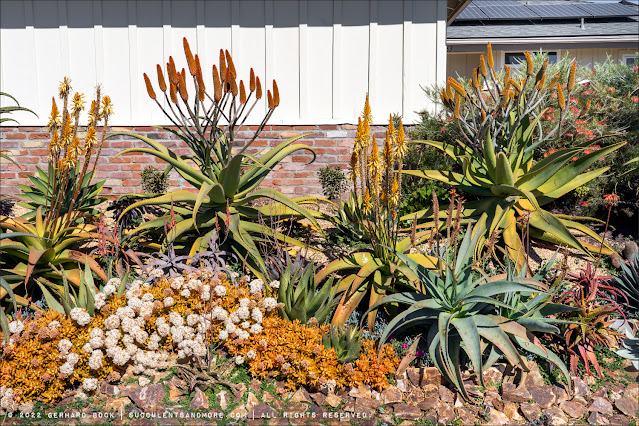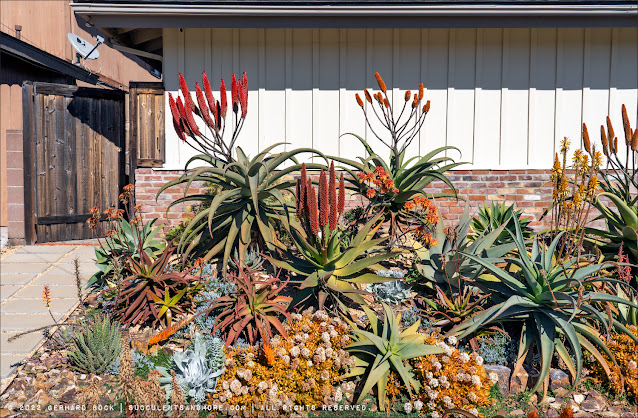Today it’s back to San Diego for what seems like a blast from the past although it hasn’t even been two months yet since my trip.
One of my personal highlights was a visit to Devon Boutte’s aloe-heavy garden near La Jolla. As you’ll see, it looks surprisingly mature, although Devon and his family have only lived here for about four years.
 |
| Davon Boutte’s front garden |
The rear garden is dominated by a swimming pool, with a patio on one side, so the room for planting is limited. Work on that space started the summer after they bought the house. “The previous owners weren’t much into gardening,” Devon remembers, “and the planters were basically open, with the exception of a sickly Phoenix roebelenii that I removed.”
 |
| On the patio in the backyard: Aloe tongaensis, Aloe sabaea, Madagascar ocotillo (Alluaudia procera), Aloe tauri, Aloe castanea × spectabilis |
 |
From the left: Aloe castanea × spectabilis, Aloe globuligemma (front center), Aloe vaombe (behind Aloe globuligemma), various mangaves, potted Aloe speciosa. The pool is off on the right.
|
 |
| Variegated Aloe africana; I love the contrast with the children’s furniture |
Devon is an enthusiastic aloe collector. Shelves in the side yard at the far end of the backyard hold hundreds of plants—probably more than a thousand. Since many are still small, it’s possible to cram such a large number into what is a fairly small space. And in the gentle climate only a few miles inland from the coast, virtually everything is happy (I’d be, too).
 |
| Just a small part of Devon’s collection |
Devon is not just a collector, he’s also a dedicated grower and hybridizer (he has a background in plant science) and actively trades with other growers. It’s impressive what he’s managed to do in his limited spare time, considering he has a full-time job and a family with young kids.
 |
More seed-grown aloe species and hybrids
|
 |
| Aloe excelsa × rubroviolacea, one of Devon’s own hybrids |
I took more photos of Devon’s collection, but I’ll spare you endless pictures of plants in 3- and 4-inch pots. Just to give you an idea, though, the plants I took home from Devon included Aloe ‘David Verity’ × speciosa, Aloe ‘David Verity’ × white-flowering ferox, Aloe comptonii × sabaea, and Aloe excelsa × capitata. All of them are unusual hybrids with exciting potential.
“One of my goals is to produce some landscape-worthy plants over the next few years and get them into production,” he told me. He also hopes he’ll be able to utilize them in his designs for work.
On a personal level, I find it immensely gratifying that so many individuals are growing aloes and other succulents and making their own hybrids. This greatly expands the range of plants that will eventually find their way into home gardens, complementing what is produced by commercial nurseries which are far more timid and risk-adverse when it comes to new plants. 
The heart of Devon’s garden is along the front of the house and the sidewalk. This part of the garden is only two years old. You can see what it used to look like in the Google Street View photo above. The front garden is a pandemic project. In 2020, finding himself working from home, Devon decided it was time to do something about the sad strips of turf and shrubbery they’d inherited from the previous owners. As a landscape architect for Schmidt Design Group in San Diego, Devon knew what to do and how to do it efficiently. After he’d settled on an overall design, he worked out the plant palette: “lots of aloes,” he says, “agaves, random succulents and several different leucadendrons and grevilleas—plants I thought would work well together.”
Once all the details like plant layout and rock placement were on paper, the dirty work began: “ripping out turf, roses, and some tired myrtis shrubs.” Working early mornings, evenings, and weekends, Devon says “it took about two months of solid work…all while still working 40-50 hours at my real job.”
Looking at the results not even two years on, I couldn’t believe how cohesive and mature everything is!
 |
| Variegated Agave attenuata on the left, Mangave ‘Bad Hair Day’ and Mangave ‘Blazing Saddles’ in the front, with a small Aloe speciosa behind the mangaves |
Here is the bed at the head of the driveway. This planter was traditionally used for foundation shrubs.
Devon’s planting scheme is a far cry from the dull and boring fotinias or eunonymus you might have seen here in the past.
 |
| The flowering aloe on the left was supposed to be Aloe tomentosa. It’s clearly a hybrid, though, because A. tomentosa has white flowers. |
But the real excitement for me started a few yards further down the driveway:
 |
| Aloe chabaudii and co. |
 |
| Aloe chabaudii |
The beds were bursting with succulent goodness. This is my kind of garden! Even though the light was on the harsh side, I’m sure you can see why I was so excited.
 |
| Dudleya brittonii and Sedum nussbaumerianum 'Coppertone' |
 |
| Agave pablocarrilloi ‘Ivory Curls’ |
 |
| Cheiridopsis sp. |
 |
| Golden barrels (Echinocactus grusonii) and Cephalophyllum ‘Red Spike’, knitted together by Senecio serpens |
 |
| Partially variegated Agave ‘Blue Glow’ on the left |
 |
| Aloe cameronii and another Dudleya brittonii |
 |
| Aloe ortholopha × spectabilis |
 |
| Aloe ortholopha × spectabilis |
 |
| Aloe ortholopha × spectabilis |
 |
| Aloe helenae with emerging inflorescences |
 |
| Aloe helenae with emerging inflorescences |
This is what exuberance looks like. And it continues in the driveway bed separating the neighbor’s property:
 |
| Driveway bed between Devon’s property and the neighbor’s. The tall aloe in the middle is Aloe ferox × africana. |
 |
| Aloe speciosa × white-flowering ferox |
 |
| Aloe ‘Swordfish’ (blooming in the front), Aloe striata (in the back) |
Seeing how Devon’s garden is so aloe-centric, I asked him when he first became interested in aloes. “I think it was probably my second year working as a designer that I really started to fall in love with them,” he said. “Our design firm seemed to really like agaves, as did I. But the fact that aloes aren’t monocarpic and can bloom repeatedly year after year, that’s really drew me to them.”
In his professional work for Schmidt Design Group, a landscape architecture firm specializing in public and commercial spaces, including parks, healthcare, office and retail, Devon expects to be using succulents more than ever in future projects. “I think most people, at least in Southern California, are coming around to the idea that designing with succulents and water-wise plants doesn’t have to equate with an arid looking landscape. They can appear lush and vibrant. It’s been my goal to achieve that look in many of my designs.”
It was heartening to hear Devon’s perspective. I regularly bemoan the lack of variety and vision in public and commercial landscapes, and it’s good to know that professionals like Devon are working from the inside to drive change. San Diego as a community, it seems to me, might be more receptive to new ideas than many other cities.
RELATED POSTS:
© Gerhard Bock, 2022. All rights reserved. To receive all new posts by email, please subscribe here.






































Devon has been so kind and helpful to me. He actually went and found Aloe 'Moonglow' for me and shipped 2 beautiful ones to me. I am so happy to learn about his background and the work he does. I can't believe he did find this Aloe hybrid when it was nowhere here in Phoenix. I am amazed with all he does that he went out and searched for them for me. Thanks for the views of his gardens. They are amazing!
ReplyDeleteWow, I didn't know that. Devon is a great guy!!!
DeleteThe transformation of the front garden is fabulous. I need more aloes - and more rock.
ReplyDeleteWe all do, LOL!
DeleteFabulous, fabulous, and in only two years is even more fabulous!
ReplyDeleteAlso a perfect example of how utterly boring a front lawn is, by comparison.
Does he irrigate at all?
I asked Devon about irrigation, and this is what he said: "I do have an irrigation system which I really only ran the first several months after planting during the establishment period. The past year I hand watered maybe 6 or 8 times.
DeleteIt doesn't get better than that!
Wow that is impressive. I hope similar gardens will pop up in the neighbourhood now as passers by observe how beautiful Devon’s garden is. A top example of an attractive waterwise garden.
ReplyDeleteWhat a beautiful and colourful landscape even without the aloe blooms. Definitely more interesting than what was there before. Hopefully Devon will start a new trend in the neighourhood and more people will follow his lead.
ReplyDeleteLush and gorgeous. Those who can grow these beauties are so lucky!
ReplyDeleteJardín sostenible e increiblemente hermoso
ReplyDelete